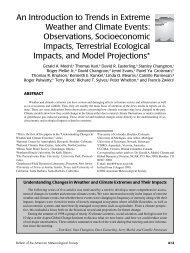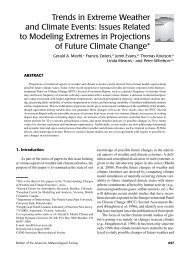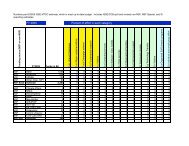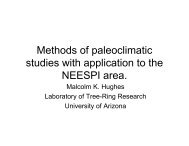The Oceanic Phosphorus Cycle
The Oceanic Phosphorus Cycle
The Oceanic Phosphorus Cycle
Create successful ePaper yourself
Turn your PDF publications into a flip-book with our unique Google optimized e-Paper software.
<strong>The</strong> <strong>Oceanic</strong> <strong>Phosphorus</strong> <strong>Cycle</strong> Chemical Reviews, 2007, Vol. 107, No. 2 573<br />
(see section 5), and bacteria were assumed to play only an<br />
indirect role. However, recent findings by Gachter and<br />
Meyer 170 suggest that not only bacteria in sediments regenerate<br />
phosphate but that they also do contribute to the<br />
production of refractory organic P compounds. Thus, such<br />
bacteria may regulate the flux of P across the sediment/water<br />
interface and contribute to its terminal burial by the production<br />
of refractory organic P compounds and biogenic apatite.<br />
8. Phosphate Oxygen Isotopic Ratios: A Tracer<br />
for Phosphate Sources and Cycling<br />
Recently, the oxygen isotope ratio in phosphate has<br />
become a more widely used tool for identifying distinct<br />
phosphate sources and understanding phosphate cycling in<br />
marine and estuarine systems. Because P has only one stable<br />
isotope, P stable isotope ratios cannot be used for studies of<br />
nutrient sources, cycling, and utilization (as is the case for<br />
nitrogen and carbon). However, most of the P found in nature<br />
is strongly bound to oxygen (O), which has three stable<br />
isotopes; hence, phosphate (PO4) can be analyzed for its<br />
oxygen isotopic composition (δ 18 Op). <strong>The</strong> P-O bond in<br />
phosphate is resistant to inorganic hydrolysis, and at the<br />
temperature and pH of most natural systems, phosphate does<br />
not exchange oxygen with water without biological mediation.<br />
171-173 Thus, any observed variability in the oxygen<br />
isotopic composition of phosphate will either reflect mixing<br />
of isotopically distinct sources of phosphate or the alteration<br />
of the phosphate δ 18 O signature as a result of the exchange<br />
of oxygen during the cycling of phosphate through living<br />
cells. In the latter case, each time a phosphate molecule is<br />
cycled (taken up by organisms and processed by enzymes),<br />
phosphate oxygen will be exchanged with cellular water,<br />
resulting in isotopic equilibrium with the surrounding water<br />
at the temperature of reaction.<br />
Results of several laboratory studies characterizing the<br />
exchange and fractionation of phosphate oxygen isotopes<br />
suggest that the δ 18 Op of DIP could be used to evaluate the<br />
degree of recycling of the DIP pool. 171,174-176 Enzymemediated<br />
turnover of phosphate and the microbially mediated<br />
degradation of organic matter demonstrated that significant<br />
exchange of oxygen isotopes between phosphate and water<br />
accompanies the hydrolytic cleavage and metabolism of both<br />
organically bound phosphate and inorganic orthophosphate.<br />
171 Bacterial metabolic processes have also been found<br />
to significantly alter the δ 18 Op of DIP in laboratory culture<br />
experiments, even when phosphate concentrations were<br />
high. 174 Furthermore, results of an algae culture experiment<br />
indicate that intracellular oxygen isotope exchange between<br />
phosphorus compounds and water is very rapid (hours to<br />
days). 176<br />
Observations, both in microbial culture experiments and<br />
in cell-free systems where specific enzymes were used, 175<br />
indicate that intracellular phosphate cycling by pyrophosphatase<br />
results in a temperature-dependent equilibrium<br />
oxygen isotope fractionation, which imparts the equilibrium<br />
δ 18 Op on phosphate recycled within cells. In contrast,<br />
extracellular phosphate regeneration by alkaline phosphatase<br />
is accompanied by disequilibrium isotope effects (both<br />
kinetic effects and inheritance of phosphate oxygen from<br />
hydrolyzed phosphomonoesters) in the inorganic phosphate<br />
released into the system. 175 However, the equilibrium isotope<br />
effects associated with intracellular phosphate cycling are<br />
expected to dominate in most natural systems. 175<br />
To date, there are relatively few studies assessing the<br />
oxygen isotopic composition of DIP in natural aquatic<br />
systems. Pioneering work by Longinelli et al. 172 found no<br />
variation in the δ18Op of DIP in seawater or of marine<br />
organism soft tissue with either depth or latitude in the<br />
Atlantic and Pacific Oceans, although there was a significant<br />
difference between the two ocean basins. <strong>The</strong> δ18Op values<br />
were thought to reflect kinetic-biological isotopic fractionation.<br />
However, Longinelli et al. 172 extracted P from seawater<br />
without prefiltration and used Fe-coated fibers which absorb<br />
both inorganic and organic P, and such complications may<br />
confound interpretation of their results. More recently,<br />
Colman177 concluded that the large deviations in δ18Op between riverine and coastal waters in the Long Island Sound<br />
reflected equilibration with local water and indicated that<br />
rapid microbial cycling overprints source δ18Op values on a<br />
time scale of weeks. In contrast, phosphate in the San<br />
Francisco Bay estuary is typically not equilibrated with<br />
environmental water and reflects two end-member mixing<br />
between oceanic phosphate and riverine phosphate with<br />
seasonally important additional riverine inputs along this flow<br />
path. 178 In California coastal waters (Monterey Bay), phosphate<br />
oxygen isotope ratios tracked seasonal changes in<br />
phosphate cycling through the biomass (e.g., phosphate<br />
utilization rates) with the greatest phosphate oxygen isotope<br />
exchange occurring during the upwelling season. 179 <strong>The</strong><br />
δ18Op in open ocean waters is a function of DIP transport<br />
and biological turnover in both the Atlantic and the Pacific<br />
Oceans and highlights the importance of cell lysis in the<br />
regeneration of DIP in the euphotic zone. Furthermore, at<br />
depth, the δ18Op values are near the temperature-dependent<br />
equilibrium, suggestive of bacterial turnover of DIP in<br />
seawater. 180 <strong>The</strong>se data suggest that the δ18Op can be used<br />
as a powerful tool for identifying and quantifying the<br />
contribution of non-point sources of phosphate pollution into<br />
some aquatic systems and has the potential to be used to<br />
determine relative rates of P cycling and utilization in marine<br />
systems.<br />
9. Summary<br />
<strong>Phosphorus</strong> is undeniably an important element in the<br />
marine environment. Its role as a limiting macronutrient for<br />
primary productivity inextricably links it to the global carbon<br />
cycle and thus the climate system over geologic time scales.<br />
However, there remain many unanswered questions or<br />
ambiguous answers to the global phosphorus cycle. Pinpointing<br />
the sources and sinks of this globally important element<br />
remain elusive, and changes of either one could greatly alter<br />
the residence time of P in the ocean and, thus, estimates of<br />
its contribution to carbon export through ocean productivity.<br />
Furthermore, anthropogenic inputs of P to the marine<br />
environment are greatly altering the source contribution of<br />
P, and the ultimate effects of these additions and how they<br />
will interact with anthropogenic inputs of nitrogen and other<br />
elements and, more importantly, how they will affect marine<br />
ecosystems are still largely unknown.<br />
With the advent of new techniques, we have gained a<br />
greater understanding of the forms of phosphorus in the<br />
marine environment and how specific organisms utilize each<br />
of these phosphorus pools. Major advances have been made<br />
not only in identifying the microorganisms which are active<br />
in the turnover of organic phosphorus compounds but also<br />
in identifying the genes which are involved in creating the<br />
enzymes that make this turnover possible. Furthermore,<br />
specific species have been identified which can utilize











![View Powerpoint Slides [PDF]](https://img.yumpu.com/32486693/1/190x146/view-powerpoint-slides-pdf.jpg?quality=85)



![View Powerpoint Slides [PDF]](https://img.yumpu.com/29411106/1/190x143/view-powerpoint-slides-pdf.jpg?quality=85)

